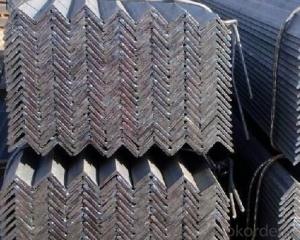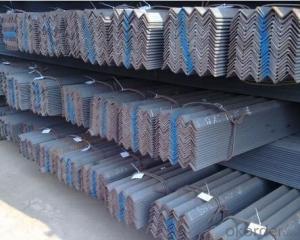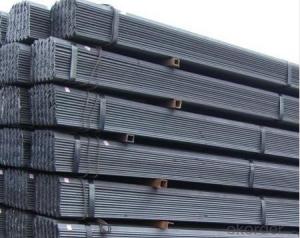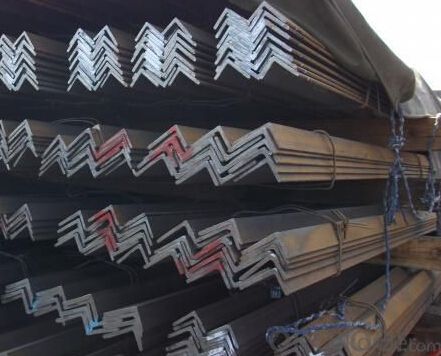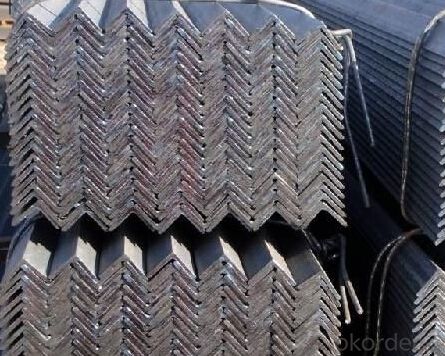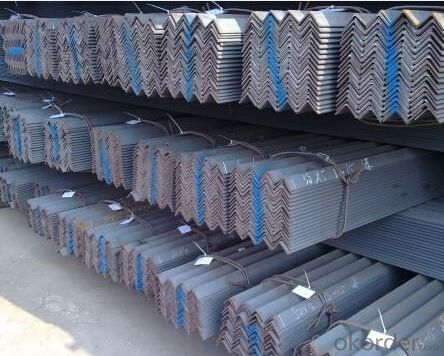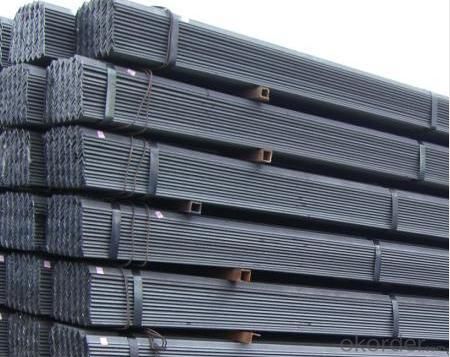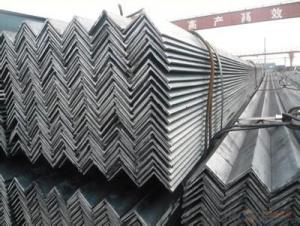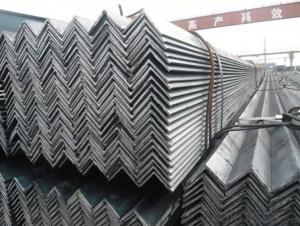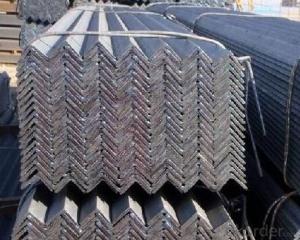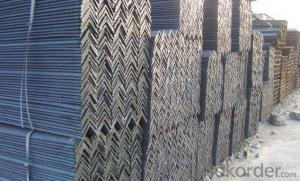Stainless Angle Steel with High Quality of GB Q235
- Loading Port:
- China Main Port
- Payment Terms:
- TT or LC
- Min Order Qty:
- -
- Supply Capability:
- -
OKorder Service Pledge
OKorder Financial Service
You Might Also Like
Product Description:
OKorder is offering Stainless Angle Steel with High Quality of GB Q235 at great prices with worldwide shipping. Our supplier is a world-class manufacturer of steel, with our products utilized the world over. OKorder annually supplies products to European, North American and Asian markets. We provide quotations within 24 hours of receiving an inquiry and guarantee competitive prices.
Product Applications:
Stainless Angle Steel with High Quality of GB Q235 are ideal for structural applications and are widely used in the construction of buildings and bridges, and the manufacturing, petrochemical, and transportation industries.
Product Advantages:
OKorder's Stainless Angle Steel with High Quality of GB Q235 are durable, strong, and resist corrosion.
Main Product Features:
· Premium quality
· Prompt delivery & seaworthy packing (30 days after receiving deposit)
· Corrosion resistance
· Can be recycled and reused
· Mill test certification
· Professional Service
· Competitive pricing
Product Specifications:
1. Standards: GB,ASTM,BS,AISI,DIN,JIS
2. Invoicing on theoretical weight or actual weight as customer request
3. Material:Material: GB Q235B, Q345B or Equivalent; ASTM A36; EN 10025, S235JR, S355JR; JIS G3192, SS400; SS540.
4. Sizes:
Sizes: 25mm-250mm | ||
a*t | ||
25*2.5-4.0 | 70*6.0-9.0 | 130*9.0-15 |
30*2.5-6.6 | 75*6.0-9.0 | 140*10-14 |
36*3.0-5.0 | 80*5.0-10 | 150*10-20 |
38*2.3-6.0 | 90*7.0-10 | 160*10-16 |
40*3.0-5.0 | 100*6.0-12 | 175*12-15 |
45*4.0-6.0 | 110*8.0-10 | 180*12-18 |
50*4.0-6.0 | 120*6.0-15 | 200*14-25 |
60*4.0-8.0 | 125*8.0-14 | 250*25 |
5. Material details:
Alloy No | Grade | Element (%) | |||||
C | Mn | S | P | Si | |||
|
|
|
|
|
|
| |
Q235 | B | 0.12—0.20 | 0.3—0.7 | ≤0.045 | ≤0.045 | ≤0.3 | |
|
|
|
|
|
|
| |
Alloy No | Grade | Yielding strength point( Mpa) | |||||
Thickness (mm) | |||||||
≤16 | >16--40 | >40--60 | >60--100 | ||||
≥ | |||||||
|
|
|
|
|
| ||
Q235 | B | 235 | 225 | 215 | 205 | ||
Alloy No | Grade | Tensile strength (Mpa) | Elongation after fracture (%) | ||||
Thickness (mm) | |||||||
| ≤16 | >16--40 | >40--60 | >60--100 | |||
≥ | |||||||
|
|
|
|
|
|
| |
Q235 | B | 375--500 | 26 | 25 | 24 | 23 | |
Usage & Applications of GB Q235 Angle Steel
Trusses;
Transmission towers;
Telecommunication towers;
Bracing for general structures;
Stiffeners in structural use.
Packaging & Delivery of GB Q235 Angle Steel
1. Transportation: the goods are delivered by truck from mill to loading port, the maximum quantity can be loaded is around 40MTs by each truck. If the order quantity cannot reach the full truck loaded, the transportation cost per ton will be little higher than full load.
2. With bundles and load in 20 feet/40 feet container, or by bulk cargo, also we could do as customer's request.
3. Marks:
Color mark: There will be color marking on both end of the bundle for the cargo delivered by bulk vessel. That makes it easily to distinguish at the destination port.
Tag mark: There will be tag mark tied up on the bundles. The information usually including supplier logo and name, product name, made in China, shipping marks and other information request by the customer.
If loading by container the marking is not needed, but we will prepare it as customer request.
FAQ:
Q1: Why buy Materials & Equipment from OKorder.com?
A1: All products offered byOKorder.com are carefully selected from China's most reliable manufacturing enterprises. Through its ISO certifications, OKorder.com adheres to the highest standards and a commitment to supply chain safety and customer satisfaction.
Q2: How do we guarantee the quality of our products?
A2: We have established an advanced quality management system which conducts strict quality tests at every step, from raw materials to the final product. At the same time, we provide extensive follow-up service assurances as required.
Q3: How soon can we receive the product after purchase?
A3: Within three days of placing an order, we will begin production. The specific shipping date is dependent upon international and government factors, but is typically 7 to 10 workdays.
Q4: What makes stainless steel stainless?
A4: Stainless steel must contain at least 10.5 % chromium. It is this element that reacts with the oxygen in the air to form a complex chrome-oxide surface layer that is invisible but strong enough to prevent further oxygen from "staining" (rusting) the surface. Higher levels of chromium and the addition of other alloying elements such as nickel and molybdenum enhance this surface layer and improve the corrosion resistance of the stainless material.
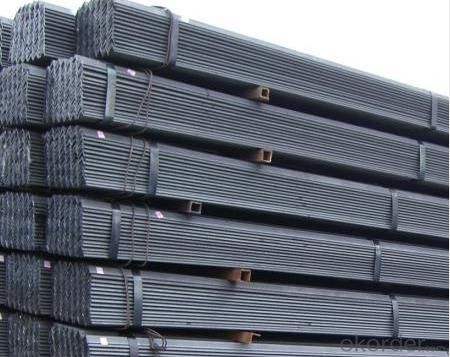
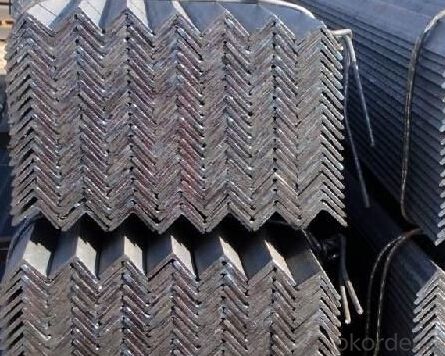
- Q: How do steel angles contribute to the overall stability of a building?
- Steel angles contribute to the overall stability of a building by providing structural support and reinforcement. They are commonly used to reinforce corners and joints in construction, helping to distribute the load and prevent the building from collapsing or experiencing excessive movement during strong winds, earthquakes, or other external forces. The angled shape of steel angles also helps to increase the rigidity and strength of the building's framework, enhancing its overall stability and durability.
- Q: How can steel angles be protected against corrosion?
- There are various methods available to protect steel angles from corrosion. One commonly used method is the application of protective coatings. These coatings serve as a barrier between the steel angles and corrosive elements, preventing direct contact and inhibiting corrosion. Paint, epoxy, or zinc-based materials can be utilized for this purpose. Another effective approach is galvanization, which entails coating the steel angles with a layer of zinc. This zinc layer acts as a sacrificial anode, meaning that when corrosion takes place, the zinc layer will corrode first, safeguarding the steel beneath. This method is particularly advantageous in harsh environments like marine or industrial settings. To prevent corrosion, regular maintenance and inspection are crucial. Any damage or deterioration to the protective coating should be promptly addressed to ensure ongoing protection. Additionally, keeping the steel angles clean and free from debris or moisture buildup can also aid in corrosion prevention. In certain situations, cathodic protection may be employed. This involves connecting the steel angles to a sacrificial anode composed of a more reactive metal, such as aluminum or magnesium. By sacrificing itself, the anode shields the steel angles against corrosion. Lastly, proper design and installation of steel angles can also contribute to their corrosion resistance. Ensuring sufficient drainage and ventilation, using materials that are compatible with the environment, and minimizing exposure to corrosive elements are all factors that can help protect steel angles against corrosion.
- Q: What are the common finishes available for steel angles?
- The common finishes available for steel angles include hot-dip galvanized, painted, and untreated/raw.
- Q: What are the limitations of using steel angles in high-temperature applications?
- The susceptibility of steel angles to thermal expansion is one limitation when using them in high-temperature applications. Similar to other materials, steel expands when heated and contracts when cooled. This characteristic can cause dimensional changes in the steel angles, potentially impacting their structural integrity and performance. Another limitation is the potential weakening of steel angles at elevated temperatures. As the temperature rises, the steel can undergo tempering, a process that reduces its hardness and increases its ductility. This can result in reduced load-bearing capacity and increased vulnerability to deformation or failure under high loads or stresses. Furthermore, steel angles are prone to oxidation and corrosion at high temperatures. When exposed to oxygen and moisture in the air, steel can form rust or iron oxide. This can weaken the steel angles and compromise their structural integrity, especially in environments with high humidity or aggressive chemical agents. In addition, steel angles may experience creep when subjected to high temperatures and constant loads. Creep refers to the gradual deformation or elongation of a material under constant stress over time. This can lead to permanent deformation and jeopardize the structural stability of the steel angles. Lastly, the thermal conductivity of steel must be carefully considered in the design and fabrication of steel angles for high-temperature applications. Steel has relatively high thermal conductivity, meaning it can quickly transfer heat. This characteristic can result in uneven heating and cooling of the steel angles, potentially causing stress concentrations or thermal gradients that could impact their performance. Given these limitations, it is crucial to thoroughly assess the suitability of steel angles for high-temperature applications and explore alternative materials or design adjustments to ensure optimal performance and safety.
- Q: Can steel angles be used in HVAC ductwork installations?
- Indeed, steel angles have the capability to be utilized in HVAC ductwork installations. In the realm of ductwork systems, steel angles are frequently employed to furnish the necessary support and stability. Their typical function involves acting as brackets or supports, securing the ducts firmly in position and preventing undesirable sagging or collapsing caused by the weight of the air conditioning or heating equipment. Given their robustness and durability, steel angles are well suited to withstand the forces and vibrations inherent in HVAC systems. Moreover, the ease with which steel angles can be welded or bolted together allows for a secure and stable installation. To summarize, steel angles are an exceedingly reliable and widely utilized element in HVAC ductwork installations.
- Q: Can steel angles be used for framing or supporting exterior façade elements?
- Steel angles have the capability to be utilized in framing or supporting exterior façade elements. In the construction industry, steel angles are frequently employed due to their robustness and endurance. They offer a steadfast and dependable support system for various architectural elements, particularly exterior façade elements. Steel angles can be employed to construct windows, doors, and other openings in the exterior walls. Furthermore, they can be utilized to enhance and sustain the weight of exterior cladding materials such as stone, glass, or metal panels. Steel angles exhibit versatility and can be effortlessly customized to suit the specific requirements of the project. They are often preferred in commercial and industrial buildings where structural stability is of utmost importance.
- Q: What is the maximum spacing for steel angles in a support structure?
- The maximum spacing for steel angles in a support structure depends on several factors including the load being supported, the size and thickness of the angles, and the specific design criteria. In general, the spacing between steel angles should be determined by the structural engineer or designer based on the maximum allowable deflection and stress criteria for the given application. Steel angles are commonly used in support structures due to their high strength and versatility. They can provide structural stability and support to various types of loads. However, excessive spacing between steel angles can lead to increased deflection and stress on the structure, potentially compromising its integrity. To determine the maximum spacing, the engineer will consider the load-bearing capacity of the steel angles, the anticipated load distribution, and any applicable building codes or industry standards. The specific design criteria will dictate the allowable deflection and stress limits, which will then be used to calculate the appropriate spacing between the angles. It is important to note that different types of support structures may have different maximum spacing requirements. For instance, in a roof truss system, the maximum spacing between steel angles may be smaller compared to a mezzanine support structure. Additionally, the maximum spacing may vary depending on whether the angles are used as primary or secondary support members. Ultimately, the maximum spacing for steel angles in a support structure should be determined through a thorough engineering analysis, taking into account the specific project requirements and safety factors. It is always recommended to consult with a structural engineer or design professional to ensure the support structure meets all necessary criteria for safety and performance.
- Q: What are the different methods of surface preparation for steel angles?
- Some of the different methods of surface preparation for steel angles include abrasive blasting, chemical cleaning, and mechanical cleaning. Abrasive blasting involves using a high-pressure stream of abrasive material to remove rust, scale, and other contaminants from the surface of the steel. Chemical cleaning involves using chemicals to dissolve and remove rust and other contaminants. Mechanical cleaning involves using tools such as wire brushes or sandpaper to physically scrape or scrub the surface of the steel to remove rust and other contaminants. These methods are important in preparing the steel surface for painting, coating, or other forms of protection against corrosion.
- Q: How do you determine the appropriate thickness of a steel angle for a specific application?
- To determine the appropriate thickness of a steel angle for a specific application, several factors need to be considered. Firstly, it is important to understand the load or weight that will be applied to the steel angle. This includes both the static load, which is the weight that the angle will bear continuously, and the dynamic load, which is any additional force that may be applied intermittently. The magnitude of the load will determine the strength requirements of the steel angle. Secondly, the length of the steel angle needs to be taken into account. Longer angles will experience greater deflection and bending, so a thicker angle may be required to provide sufficient rigidity and prevent deformation under the load. Another crucial factor to consider is the type of steel being used. Different grades of steel have varying strength properties, and the appropriate thickness will depend on the specific grade. It is important to consult the material specifications and standards to ensure the chosen steel angle meets the required strength and durability criteria for the application. Furthermore, the support conditions and the method of attachment should be considered. The way the steel angle is connected to other structural elements will affect its load-bearing capacity. If the angle is bolted or welded to other components, its thickness must be chosen to suit the specific connection method and account for any additional stresses induced by the attachment process. Lastly, any applicable industry standards, codes, or regulations should be followed when determining the appropriate thickness of a steel angle. These standards often provide guidelines or calculations for selecting the correct size and thickness based on the intended application, load, and other design factors. In summary, determining the appropriate thickness of a steel angle for a specific application requires considering factors such as the load magnitude, length, steel grade, support conditions, and attachment method. Consulting material specifications, industry standards, and seeking professional advice can help ensure the chosen steel angle meets the required strength and durability requirements.
- Q: What are the different types of steel coatings available for angles?
- There are several different types of steel coatings available for angles, each with its own unique characteristics and benefits. Some of the most common types include: 1. Galvanized coating: This is one of the most popular and widely used types of steel coating for angles. Galvanization involves applying a layer of zinc to the surface of the steel, providing excellent corrosion resistance. Galvanized angles are commonly used in outdoor applications or in environments where moisture and humidity are present. 2. Powder coating: Powder coating is a type of dry finishing process that involves applying a fine powder to the surface of the steel angles. The powder is electrostatically charged and adheres to the metal, creating a smooth, durable, and attractive finish. Powder coating provides excellent resistance to scratches, chipping, and fading, making it a popular choice for decorative or architectural applications. 3. Epoxy coating: Epoxy coatings are a type of thermosetting polymer that is applied to the surface of the steel angles. These coatings provide exceptional resistance to chemicals, corrosion, and abrasion, making them suitable for harsh and demanding environments. Epoxy-coated angles are commonly used in industrial settings, such as chemical plants or wastewater treatment facilities. 4. Paint coating: Paint coatings are a traditional and cost-effective option for steel angles. They are typically applied as a liquid and can be customized in terms of color and finish. While paint coatings provide some level of protection against corrosion, they may not be as durable or long-lasting as other types of coatings. However, they can still be suitable for indoor or low-corrosion applications. 5. Organic coating: Organic coatings, such as polyurethane or polyester, are often used to provide a decorative or protective layer to steel angles. These coatings offer excellent resistance to UV radiation, weathering, and fading, making them suitable for outdoor applications. Organic-coated angles can be found in architectural, construction, or infrastructure projects. It's important to consider the specific requirements of your application when choosing a steel coating for angles. Factors such as environmental conditions, aesthetic preferences, and durability needs should all be taken into account to ensure the proper selection of the coating that best suits your project.
Send your message to us
Stainless Angle Steel with High Quality of GB Q235
- Loading Port:
- China Main Port
- Payment Terms:
- TT or LC
- Min Order Qty:
- -
- Supply Capability:
- -
OKorder Service Pledge
OKorder Financial Service
Similar products
Hot products
Hot Searches
Related keywords

